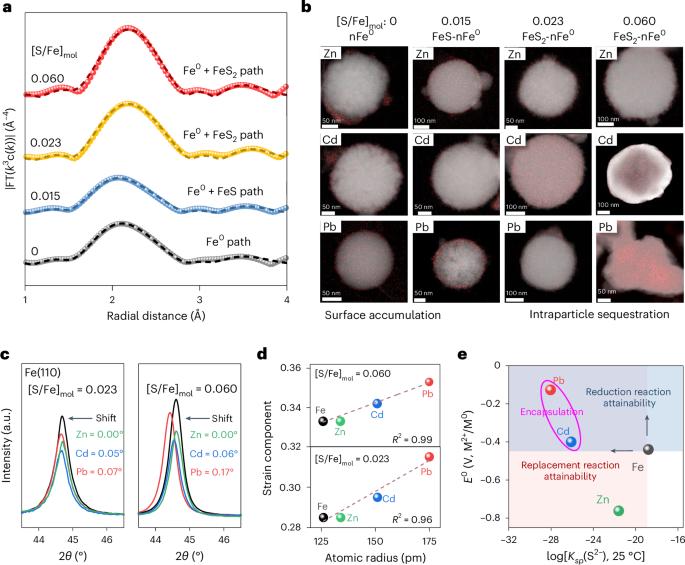用于长期金属封装的浸渍硫晶格零价铁晶体
IF 25.7
1区 环境科学与生态学
Q1 ENVIRONMENTAL SCIENCES
引用次数: 0
摘要
利用纳米级零价铁(nFe0)材料去除重金属是就地修复地下水污染的一种可行方法。然而,传统的 nFe0 材料对各种电子受体(如水)具有不加区分的反应性,只会在表面积累重金属,从而导致选择性差、寿命短。在这里,我们开发了一种晶格硫浸渍 nFe0(S-nFe0),通过类似于 Kirkendall 的增强效应实现了重金属的粒子内封存。这种金属螯合方法能与水竞争电子,并有效利用铁释放点,反应后的 S-nFe0 具有惰性,不会在实际地下水基质中释放金属(比 nFe0 少 78-220 倍)。据估计,处理后的地下水可达到饮用水标准,寿命超过 20-100 年。根据 Biwer-Heinzle 环境评估结果,合成 S-nFe0 对环境的影响可以忽略不计。S-nFe0 在金属污染地下水修复方面的生产和运营成本也具有竞争力。总之,这项工作提出了一种在 nFe0 中实现金属封装的策略,打破了氧化还原纳米材料的反应性-选择性-稳定性权衡,为解决地下水污染问题提供了一种强有力的工具。纳米级零价铁(nFe0)材料在地下水污染修复方面有着悠久的历史,但传统的 nFe0 存在固有缺陷。在此,作者开发了一种晶格硫浸渍 nFe0,可高效、选择性地去除重金属并长期封装金属。本文章由计算机程序翻译,如有差异,请以英文原文为准。

Lattice-sulfur-impregnated zero-valent iron crystals for long-term metal encapsulation
Using nanoscale zero-valent iron (nFe0) materials for heavy metal removal is a viable approach for in situ groundwater pollution remediation. However, conventional nFe0 materials have indiscriminate reactivity towards various electron acceptors (for example, water) and just accumulate heavy metals onto the surface, which leads to poor selectivity and short longevity. Here we develop a lattice-sulfur-impregnated nFe0 (S-nFe0), achieving intraparticle sequestration of heavy metals enabled by a boosted Kirkendall-like effect. This metal-encapsulation approach outcompetes water for electrons and efficiently uses Fe-released spots, and the reacted S-nFe0 becomes inert to release metals (78–220× less than nFe0) in real groundwater matrices. The treated groundwater is estimated to meet drinking-water standards with a longevity of over 20–100 years. The synthesis of S-nFe0 has negligible environmental impacts according to Biwer–Heinzle environmental evaluation results. S-nFe0 also shows competitive production and operation costs for metal-contaminated groundwater remediation. Overall this work presents a strategy for achieving metal encapsulation in nFe0, which breaks the reactivity–selectivity–stability trade-offs of redox nanomaterials, providing a powerful tool to tackle groundwater pollution. Nanoscale zero-valent iron (nFe0) materials have a long history in groundwater pollution remediation but conventional nFe0 has intrinsic shortcomings. Here the authors develop a lattice-sulfur-impregnated nFe0 that enables efficient and selective heavy metal removal and long-term metal encapsulation.
求助全文
通过发布文献求助,成功后即可免费获取论文全文。
去求助
来源期刊

Nature Sustainability
Energy-Renewable Energy, Sustainability and the Environment
CiteScore
41.90
自引率
1.10%
发文量
159
期刊介绍:
Nature Sustainability aims to facilitate cross-disciplinary dialogues and bring together research fields that contribute to understanding how we organize our lives in a finite world and the impacts of our actions.
Nature Sustainability will not only publish fundamental research but also significant investigations into policies and solutions for ensuring human well-being now and in the future.Its ultimate goal is to address the greatest challenges of our time.
 求助内容:
求助内容: 应助结果提醒方式:
应助结果提醒方式:


